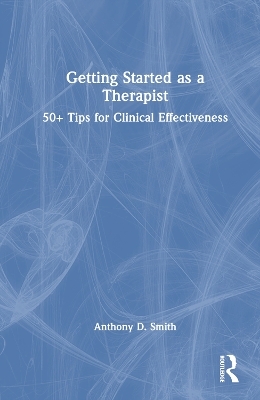
Getting Started as a Therapist
Routledge (Verlag)
978-1-032-62346-7 (ISBN)
- Noch nicht erschienen (ca. Oktober 2024)
- Versandkostenfrei innerhalb Deutschlands
- Auch auf Rechnung
- Verfügbarkeit in der Filiale vor Ort prüfen
- Artikel merken
• Establishing better therapeutic relationships
• Increasing diagnostic accuracy, understanding why diagnosis is not a dirty word, and how it is critical to good outcomes
• What to avoid saying to patients
• Specialized topics like how to more effectively talk about self-injury and learning to use metaphors
• Professional development such as making the most of supervision and how to limit liability
The succinct chapters come alive with real-life examples and are often followed by suggestions for further reading and worksheets that help readers to refine their practice.
Anthony D. Smith is a licensed mental health counselor, certified juvenile court clinician, professor, clinical supervisor, and trainer with more than twenty years of experience. He maintains “Up & Running,” a popular Psychology Today blog for new therapists.
Section 1: Setting the Stage 1. It’s Not Like on TV 2. Be Yourself 3. Therapy Isn’t a Race 4. Don’t Forget the Basics 5. Forget About Being So Formal 6. Mastering Your Therapeutic Presence 7. Body Language Basics 8. How to Polish Your Summarizing 9. Find Value in Silence 10. Strive to Cultivate Substance in Each Session 11. Ask About Meaning 12. Be Attentive to Your Intuition 13. Don't Rely on Psychological Archaeology Section 2: Things Therapists Shouldn't Say 14. The Big 3 15. Beware of the Suck-It-Up Trap 16. What Not to Say to Anxious Patients 17. What Not to Say to Depressed Patients 18. What Not to Say to People Who Hear Voices Section 3: Demystifying Diagnosis 19. Ignore Popular Culture Portrayals of Mental Illness 20. In Defense of Diagnosis (Part 1) 21. In Defense of Diagnosis (Part 2) 22. Post-Diagnosis Considerations 23. Never Diagnose Based on One Chief Symptom 24. Re-Evaluate Historical Diagnoses 25. 5 Quick Tips for More Thorough Assessments 26. Always Consider Medical Mimicry 27. How to Evaluate for Medical Mimicry 28. How to Discuss Diagnoses with Patients Section 4: Special Topics 29. Interview, Don't Interrogate 30. Try Not to be Alarmist 31. Be Familiar with the Defenses 32. Approach Trauma Lightly 33. Learn About Self-Injury 34. Exploring Therapist Self-Disclosure 35. There's No Need to Rescue 36. Why Therapists Must be Salespeople 37. Learn to Reframe 38. Getting Friendly with Metaphors 39. What if Someone Implies, "You'd Never Understand"? 40. Pay Attention to the Role of Culture 41. Talk About Medications 42. Personality Disorders are Important 43. Ask for Feedback Section 5: Professional Development 44. Consider an Integrative Approach 45. Limiting Liability 46. Clinical Supervision if Vital for Therapist Growth 47. Take Continuing Education Seriously 48. Have Clinical Heroes 49. Improve Your Clinical Skills After Hours 50. Do Therapists Need Therapy? 51. Protecting Your Own Mental Health 52. You Can't Save Them All
| Erscheint lt. Verlag | 15.10.2024 |
|---|---|
| Verlagsort | London |
| Sprache | englisch |
| Maße | 152 x 229 mm |
| Themenwelt | Sachbuch/Ratgeber ► Gesundheit / Leben / Psychologie |
| Geisteswissenschaften ► Psychologie ► Allgemeine Psychologie | |
| Medizin / Pharmazie ► Medizinische Fachgebiete ► Psychiatrie / Psychotherapie | |
| ISBN-10 | 1-032-62346-2 / 1032623462 |
| ISBN-13 | 978-1-032-62346-7 / 9781032623467 |
| Zustand | Neuware |
| Haben Sie eine Frage zum Produkt? |
aus dem Bereich


